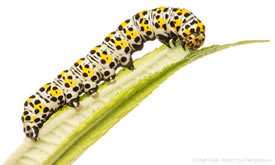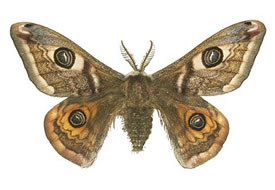
Dimdima
Online Children's Magazine from India

Dimdima
Online Children's Magazine from India


IN 1869, the French astronomer, Leopold Trouvelot, then teaching at Harvard University in the USA, was conducting experiments on butterflies and gypsy moths he had brought from Europe. He was careless and one day a few gypsy moth caterpillars escaped from the cage in which he had kept them. He and his students searched for the caterpillars but could not find a single one. In the end, the astronomer called off the search, reasoning that a few caterpillars could do no harm.
But he was wrong. The caterpillars turned into moths, which in turn laid eggs and produced more moths. Gypsy moth larvae eat a variety of leaves and they are voracious eaters.
 Within two decades the population of gypsy moths in the area had become big enough to devastate a forest near the town of Medford from where they had escaped. Then they descended on the town itself. There they ate the leaves of trees in the parks and orchards and when the trees were laid bare, invaded homes to feed on clothes and mattresses. Soon there were caterpillars everywhere in the town. People could not walk on the pavement without crushing a few of the caterpillars underfoot. From Medford they fanned out to other areas in the USA. By 1901 gypsy moths had spread over a large part of the country.
Within two decades the population of gypsy moths in the area had become big enough to devastate a forest near the town of Medford from where they had escaped. Then they descended on the town itself. There they ate the leaves of trees in the parks and orchards and when the trees were laid bare, invaded homes to feed on clothes and mattresses. Soon there were caterpillars everywhere in the town. People could not walk on the pavement without crushing a few of the caterpillars underfoot. From Medford they fanned out to other areas in the USA. By 1901 gypsy moths had spread over a large part of the country.
The government, in a bid to reduce their population, imported and released into the wild, large quantities of a species of beetle that feeds on gypsy moth caterpillars. This was followed by the introduction of other natural enemies of the moth, including six species of parasitic wasps and four species of flies.
All these insects have succeeded in keeping the population of the moth in check, but today the moth can be found all over the continent, as far north as southern Canada.
Last updated on :6/15/2015
EXPLORE MORE...
COMMENT ON THIS ARTICLE
Wants to share something related to this article? Please use the form below.
Dimdima is the Sanskrit word for ‘drumbeat’. In olden days, victory in battle was heralded by the beat of drums or any important news to be conveyed to the people used to be accompanied with drumbeats.
Bharatiya Vidya Bhavan
K. M Munshi Marg,
Chowpatty, Mumbai - 400 007
email : editor@dimdima.com
Bharatiya Vidya Bhavan
505, Sane Guruji Marg,
Tardeo, Mumbai - 400 034
email : promo@dimdima.com
Dimdima.com, the Children's Website of Bharatiya Vidya Bhavan launched in 2000 and came out with a Printed version of Dimdima Magazine in 2004. At present the Printed Version have more than 35,000 subscribers from India and Abroad.